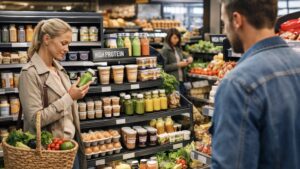Product lifecycle management for sustainability can change how companies see product development and environmental responsibility. Furthermore, as there is growing pressure on businesses to reduce their ecological footprint, it gives a comprehensive framework. This is to combine sustainability principles throughout the entire product cycle. Moreover, this approach goes further than the traditional eco-friendly initiatives. So product lifecycle management can help in reducing the consumption of resources. It can also help to minimize waste and create products that are environmentally friendly and economically viable.
In this article, we will explore the main strategies for implementing sustainable practices in product lifecycle management. So, it will provide insights into eco-design, material selection, sustainable distribution, and much more.
Sustainable Product Lifecycle Management: Eco-Design and Material Selection
Eco-design and selection of materials form the base of product lifecycle management. it sets the stage for the impact of a product on the environment throughout its lifecycle. So, let’s dive into some methods under it:
Principles of Eco-Design
Advanced eco-design has the ability to combine the following:
- Biomimicry: It includes emulating nature’s time-tested patterns and strategies. So, it, in turn., creates inherently sustainable products
- Cradle-to-cradle Philosophy: It removes the concept of waste by ensuring that the materials are infinitely recyclable or biodegradable.
- Systems Thinking: It sees the broad impact of a product on the ecosystem and society. There are some parametric design tools and AI-driven simulations that optimize the performance of a product and minimize environmental impact.
So, these principles drive innovation in materials, manufacturing processes, and even the functionality of a product.
Sustainable Material Sourcing
Choosing environmentally friendly materials stands crucial for minimum ecological footprint. So, companies should focus on recycled and recyclable materials, renewable resources, and bio-based alternatives rather than petroleum-based plastics. Furthermore, low-impact materials with small carbon footprints or less water usage in production should be chosen. Moreover, sourcing materials locally can be extremely effective. This is because it will reduce transportation and support the local economies. Additionally, when making a choice of materials, consider the entire impact including extraction, processing, use, and disposal.
Life Cycle Assessment (LCA)
LCA is an important tool in sustainable product lifecycle management. It gives a deep analysis of a product’s impact on the environment. Furthermore, it identifies hotspots of environmental impact that allow companies to focus their sustainability efforts where significant. Moreover, it helps businesses to make an informed choice when it comes to green manufacturing processes, materials, and end-of-life strategies. As a result, it leads to better environmental performance.
Sustainable PLM: Efficient Manufacturing Processes
The key to reducing the consumption of energy, waste generation, and impact on the environment lies in optimizing the manufacturing processes. So, let us see some strategies to do so:
Energy Efficiency in Production
Energy saving measures are a powerful approach in approaching reduction in carbon emissions and operating costs. Furthermore, regular energy audits, investing in high-efficiency equipment, and smart scheduling can be a great way to do it. Moreover, combining renewable energy sources and heat recovery systems can reduce reliance on fossil fuels. Then, advanced monitoring and control systems can come in handy. They can help manage energy use in real time by allowing quick adjustments to optimize consumption.
Waste Reduction and Resource Optimization
A sustainable product lifecycle management requires waste reduction. Lean green manufacturing practices can streamline processes and also remove non-value-adding activities. Furthermore, digital prototyping is powerful as well to reduce waste in the development process. Moreover, water conservation technologies and by-product synergy initiatives can be useful to reduce resource consumption. Additionally, by seeing waste as a potential resource, companies can find innovative methods to repurpose materials and create an additional value stream while reducing environmental impact.
Sustainable Supply Chain Management
The supply chain forms a major part of comprehensive product lifecycle management. It includes collaborating with suppliers to improve environmental performance. It also includes setting the sustainability criteria for supplier selection and fostering transparency. Furthermore, using supplier scorecards that include sustainability metrics can give consistent improvement. Moreover, companies should work with suppliers to reduce packaging waste, optimize transportation, and explore innovative processes.
Product Lifecycle Management: Sustainable Distribution and Packaging
Rethinking strategies for distribution and design in packaging can give major environmental benefits in product lifecycle management. So, let us go through a few methods of it ahead:
Optimized Logistics and Transportation
Transportation efficiency is key to minimizing the environmental impact of product distribution. Some of the methods to do so are:
- Route optimization software
- Making a move toward electric or hybrid vehicles
- Using intermodal transport
Furthermore, load optimization gives a great way to maximize vehicle capacity utilization and reduce the no. of trips required. Moreover, companies should also see collaborative shipping arrangements and alternate delivery methods. This can include bicycle couriers for urban last-mile delivery.
Green Warehousing Practices
Sustainable warehousing practices are effective in making the process environmentally friendly. It includes:
- Using energy-efficient lighting and HVAC systems,
- Using automated storage and retrieval systems to optimize space usage
- And renewable energy sources like solar panels
Furthermore, green building certificates like LEED can guide the warehouses’ designs and operations. Organizations can also enhance sustainability through paperless systems and electric forklifts. Moreover, inventory management systems are also powerful in reducing waste and improving operational efficiency.
Reverse Logistics
Reverse logistics systems are crucial in recovering value from returned products, reducing waste, and improving sustainability efforts. It includes making a streamlined process when it comes to handling all the returns, repairs, and end-of-life collection. Furthermore, companies should design products with ease of assembly in mind. This facilitates repairs and recycling. Moreover, tracking systems should come in use for returned products. This provides valuable data so that product design and durability can go through improvement.
Sustainable PLM: End-of-Life Management
To close the loop in sustainable product lifecycle management, effective end-of-life management becomes significant. So, let us see how to achieve this further in this section:
Product Take-back and Recycling Programs
Making systems that has the ability to reclaim or responsibly manage products at the end of the useful cycle is important for a circular economy. Furthermore, consumer participation can go through an increase by making convenient collection points and offering incentives. Moreover, material recovery can be done through partnerships with specialized facilities for recycling. These upcycling initiatives can create great value from the products that go through returns. However, consumer education is important for the program to be a success. These programs not only reduce waste but also give great insights into the durability of the product and usage patterns.
Digital Twin Technology for EOL Planning
This technology uses virtual replicas of physical products to optimize the end-of-life processes. It creates a well-detailed digital model where companies can simulate various decomposition, recycling, and repurposing scenarios before actually using them. So, it allows for identifying the potential challenges or inefficiencies that help in minimizing waste of physical trials and reduce cost. Furthermore, it provides real-time data on product wear and degradation, facilitates predictive maintenance, and gives accurate end-of-life timing. As a result, it helps to lead to a more efficient recovery of resources, waste reduction, and improvement in circular economy practices.
Extended Producer Responsibility (EPR)
EPR policies give the onus to the manufacturers to manage the lifecycle of a product including end-of-life disposal. It gives incentives to companies to design products having sustainability in mind from the start. Furthermore, it leads to innovative programs of take-back, improvement in recycling infrastructure, and more efficient use of resources. By following this policy, companies can improve their reputation for sustainability. This is becoming a crucial factor for many consumers before buying from a company.
To Sum Up
Product lifecycle management is a long process but stands crucial. It needs to be done right by businesses that aim to reduce their environmental impact and meet eco-friendly product demands. Furthermore, following the strategies discussed in the article can help you do so effectively. However, it is an area that needs continuous learning and improvement. A great way to do so is to attend the Net-Zero Supply Chain Summit where topics like these and more will be discussed.
It covers areas like Examining the regulations driving sustainable supply chains, AI and Big Data for carbon footprint management, Innovative solutions for more sustainable warehousing and logistics, Green transportation and fleet electrification, and more. Moreover, the summits come with a ton of sessions, case studies, panel discussions, and more by industry leaders, experts, and policymakers. So, it will also be a great opportunity to network and grow. The event takes place on 12-13 September 2024 in Amsterdam, Netherlands. So, make sure you check out all the details and register now!




